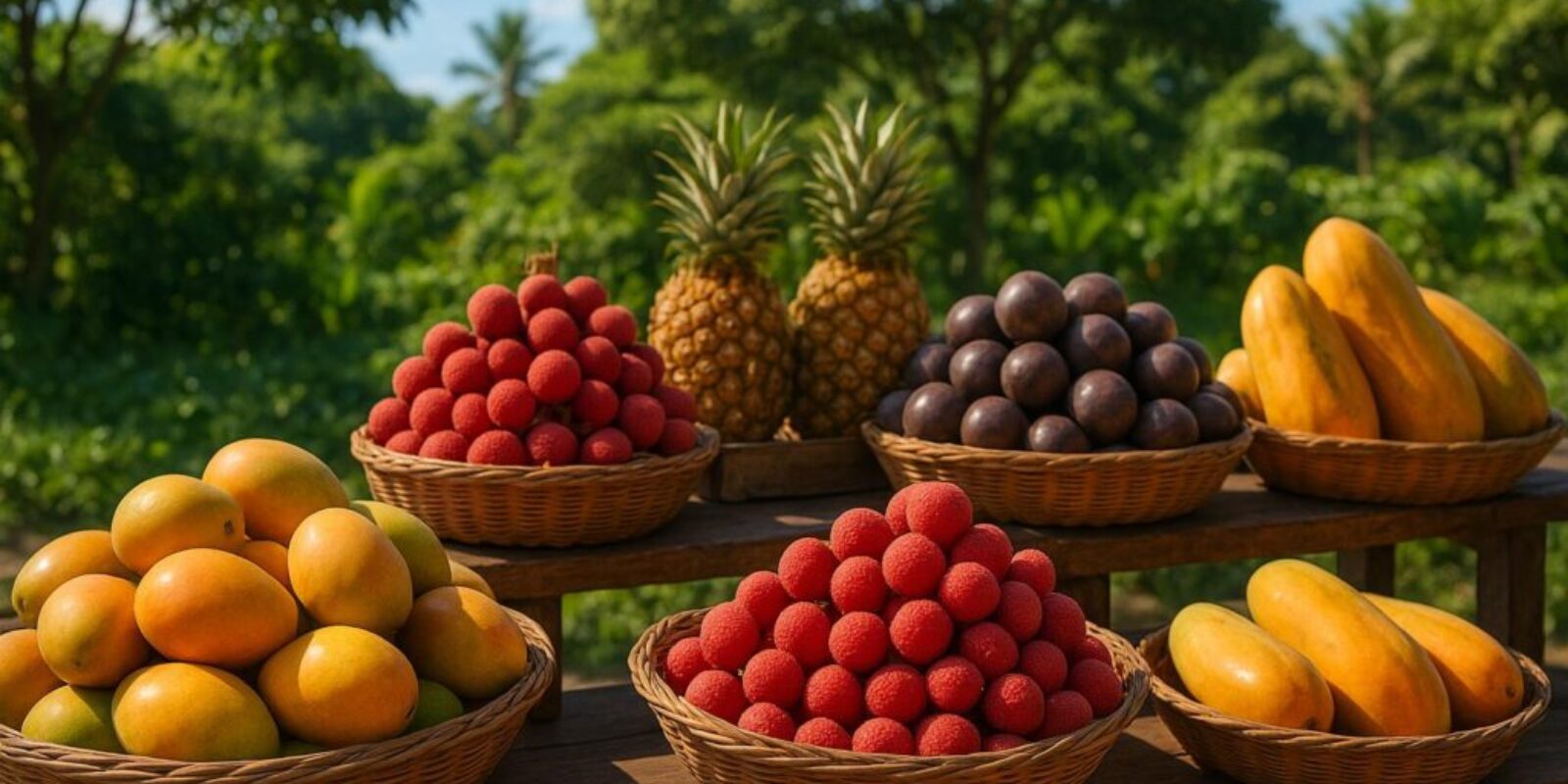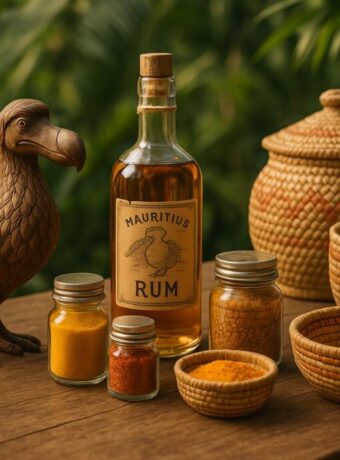- Lychee (Litchi): Sweet, floral, and juicy. Best enjoyed fresh in November–December at markets or plantations.
- Mango: Rich and sun-kissed flavor. Peak season is October–January, perfect for juices, chutneys, or raw slices with chili.
- Banana: Unique varieties with hints of vanilla or apple. Available year-round and used in desserts or as crispy chips.
- Longan: Sweet, musky, and grape-like. January–March is the time to indulge in this subtle-flavored fruit.
- Guava: Tart or sweet depending on ripeness. April–May is guava-picking season in cooler areas like Plaine Champagne.
- Carambola (Starfruit): Crisp, tangy-sweet, and star-shaped. February–July is the best time to sample it fresh or in salads.
- Breadfruit: Mild, starchy, and hearty. Enjoy it cooked in curries or roasted, especially between October–June.
Quick Comparison Table
| Fruit | Peak Season | Flavor Profile | Common Uses |
|---|---|---|---|
| Lychee | Nov–Dec | Sweet, floral, juicy | Fresh, desserts, cocktails |
| Mango | Oct–Jan | Sweet, rich, tropical | Juices, chutneys, raw |
| Banana | Year-round | Sweet, creamy, vanilla/apple notes | Snacks, desserts, chips |
| Longan | Jan–Mar | Sweet, musky, grape-like | Fresh, desserts |
| Guava | Apr–May | Tart or sweet, floral | Juices, jams, fresh |
| Starfruit | Feb–Jul | Tangy-sweet, crisp | Fresh, salads, pickles |
| Breadfruit | Oct–Jun | Mild, starchy, potato-like | Curries, roasted, fritters |
Why Visit Mauritius?
With its warm climate and vibrant markets, Mauritius offers a unique fruit-tasting experience. From lychee orchards to roadside mango stands, every fruit has a story and a flavor worth exploring. Dive into the island’s rich fruit culture at plantations, local markets, or guided tours for an unforgettable tropical adventure.
🤩 Delicious Mauritius 🇲🇺 AMAZING FOOD TOUR in Central Flacq Market 🇲🇺

1. Lychee (Litchi)
Locally known as "litchi", this tropical fruit is a beloved seasonal treat. Beneath its bumpy, reddish-pink shell lies a translucent, juicy flesh that offers a flavor as unique as its appearance.
Flavor Profile
Lychee boasts a sweet yet slightly tart flavor with a hint of citrus, often compared to strawberry or pear. Its texture resembles a crisp, firm grape, and it carries subtle floral and mildly acidic notes. With hints of melon, berries, and a delicate floral aroma – sometimes reminiscent of rose – lychee is a refreshing addition to cocktails, sorbets, and tropical salsas. This light and aromatic profile has cemented its place as a favorite in Mauritian dishes.
Seasonal Availability
November and December mark the peak lychee season in Mauritius. During these months, trees are laden with fruit, and local markets overflow with fresh harvests. It’s also common to spot roadside vendors selling lychees straight from the orchards. These months provide the perfect opportunity to enjoy the fruit at its freshest while exploring bustling markets and scenic spots.
Best Tasting Locations or Tours
For the freshest lychees, head to markets such as Port Louis Central, Flacq, or Quatre Bornes. Arriving early in the morning not only gives you access to the best produce but also the chance to negotiate prices. For a more immersive experience, the Saint Aubin Plantation offers guided lychee tastings alongside other tropical fruits. Goodlands market also becomes a lively hub for lychee lovers during the season.
If you’re looking for something different, consider a specialized tour. In April 2025, a visitor named Jane raved about her experience on a combined lychee wine, tea, and rum tour, highlighting the guide’s detailed explanations. It’s a delicious way to explore the versatility of this tropical gem.
2. Mango
Mangoes are a beloved tropical fruit in Mauritius, celebrated for their vibrant taste and impressive variety.
Let’s dive into what makes Mauritian mangoes so special.
Flavor Profile
Mauritian mangoes are famed for their rich orange flesh and juicy sweetness. Among the many varieties, "Mang Josee" and "Maison Rouge" are particularly praised for their exceptional flavor. As one local puts it:
"Mauritian mangoes carry the warm, sun-kissed essence of the Indian Ocean in every bite."
The island’s tropical climate infuses these mangoes with a natural sweetness, making them perfect for enjoying fresh or incorporating into recipes.
Seasonal Availability
Mango season in Mauritius peaks in November, with fresh mangoes available from October through January. During this time, street vendors are a common sight, selling mangoes straight from local orchards.
This seasonal abundance also underscores the fruit’s importance in Mauritian cuisine.
Cultural and Culinary Significance
Mangoes hold a cherished place in Mauritian food culture. Drawing from Indian culinary traditions, they’re often pickled, dried, or spiced to complement dishes like curries. The Creole community adds its own twist, enjoying raw mango slices with a sprinkle of lemon and chili for a tangy, spicy treat. Restaurants and bars also embrace the season, serving mango juice blended with ice for a refreshing tropical drink.
Best Tasting Locations or Tours
For a true mango experience, visitors can explore several unique spots around Mauritius. At the Labourdonnais Plantation in the north, you can taste a variety of mangoes from century-old trees, along with fresh juices and homemade jams. If you prefer a laid-back vibe, Le Fruit Shack at Flic en Flac serves juicy mangoes right on the beach, offering a perfect blend of flavor and scenery. Local markets like Port-Louis, Flacq, and Quatre Bornes are also must-visit destinations during mango season, brimming with a wide array of varieties.
3. Banana
Bananas in Mauritius are a delightful surprise, offering a flavor experience that’s far removed from the standard supermarket varieties. Thanks to the island’s tropical climate and the diversity of banana cultivars grown here, these bananas deliver a taste that goes way beyond the familiar Cavendish. Like many tropical fruits in Mauritius, bananas captivate visitors not just with their flavors but also with their cultural importance.
Flavor Profile
Mauritian bananas come in a variety of flavors that extend far beyond the mild sweetness of the Cavendish variety. For example, the Nam Wah variety is known for its sweet, vanilla-like flavor, while the Manzano banana offers a unique mix of apple and strawberry notes. Some local varieties even echo the flavors of the historic Gros Michel banana, which is sweeter, creamier, and has a hint of floral undertones. The combination of the island’s rich soil, tropical weather, and traditional farming techniques enhances the natural sweetness and depth of flavor in these bananas.
Seasonal Availability
Bananas in Mauritius are available all year, but they’re at their sweetest and most flavorful during the summer months, when the warm weather intensifies their natural sugars.
Cultural and Culinary Significance
Bananas hold a meaningful place in Mauritian culture, symbolizing a tradition of sharing and community. There’s a common belief on the island that fruits growing along roadsides or in fields are for everyone to enjoy – provided the plants themselves are not damaged. This custom creates a unique bond between locals and visitors, with banana trees in public spaces often treated as shared resources to be appreciated responsibly.
Best Tasting Locations or Tours
For a firsthand experience, visit La Plantation de Mon Repos, where you can taste freshly picked bananas while exploring lush banana and coconut groves. Another must-visit is the Banana Chips Factory, where you can see how fresh bananas are turned into crispy banana chips, along with tastings of various banana-based treats. Additionally, local markets across Mauritius offer a chance to explore and compare the many banana varieties, letting you savor the full range of flavors the island has to offer. These spots provide not just delicious bites but also an immersive dive into Mauritius’ vibrant food culture.
4. Longan
Longan brings a distinct flavor to Mauritius’ fruit scene. This small, round fruit with translucent flesh has been part of the island’s agricultural landscape since 1764, thanks to botanist Jean‑François Charpentier of Cossigny de Palma. Its presence in local tasting tours showcases the variety of fruits Mauritius has to offer.
Flavor Profile
Longan’s flavor is sweet and mild, with a hint of muskiness. Its sweetness is often described as dry, similar to dates, without any tangy or sour undertones. Many compare its taste to musky grapes, making it a favorite for those who enjoy subtle, layered flavors.
Seasonal Availability
In Mauritius, the longan season runs from January to March, with the fruit reaching its peak ripeness in January and February. During this time, longans are widely available across the island, making it the perfect season to enjoy them at their best.
Best Tasting Locations or Tours
To enjoy longan at its freshest, head to local markets like Port‑Louis Central, Flacq, or Quatre Bornes, where vendors proudly display the season’s harvest. For a deeper experience, visit fruit plantations such as Saint Aubin Plantation, Labourdonnais Plantation, or Mon Repos Plantation during the season. You can also find longan featured in seasonal dishes at open-air stands and restaurants like Le Fruit Shack in Flic en Flac or Casela Restaurant. These spots offer a chance to savor the fruit in creative culinary forms.
5. Guava
Guava, known locally as "Goyaves de Chine", is a beloved tropical fruit in Mauritius, celebrated for its range of flavors and its connection to local traditions. This fruit is more than just a treat for the taste buds – it’s a symbol of the island’s rich cultural heritage and seasonal festivities.
Flavor Profile
Guava offers a delightful variety of flavors. When fully ripe, it delivers a sweet taste with subtle floral notes, while less ripe guavas are tart and have a firmer texture. The white-fleshed guava is mildly sweet with a delicate floral touch, whereas the pink-fleshed variety is bolder, with a tangy and vibrant flavor. Unique types like the Strawberry guava, with its berry-like sweetness, and the Ruby Supreme guava, known for its rich red flesh and tangy-sweet taste, showcase the fruit’s diversity. Its texture ranges from smooth and creamy to slightly grainy, adding to the sensory experience.
Seasonal Availability
The guava season in Mauritius typically peaks in April and early May. During this time, the island comes alive with guava-picking traditions, a favorite activity for families and communities. Vendors can be seen selling fresh guavas from bike trunks in towns like Curepipe, offering varieties such as red, yellow, and gargoulette. This seasonal abundance makes guava a highlight of the island’s tropical harvest.
Cultural and Culinary Significance
Guava holds a special place in Mauritian culture, particularly during the harvest season. It’s not just about eating the fruit fresh – locals add crushed salt and chili for a spicy-sweet twist or use guavas to make jams, coulis sauces, and vinaigrettes. These culinary traditions bring people together, creating cherished moments centered around this versatile fruit.
Best Tasting Locations or Tours
For a memorable guava-picking adventure, head to Plaine Champagne, situated at about 1,970 feet above sea level. The cooler mountain air fosters ideal growing conditions for guava trees. Other great spots include the Black River Gorges area, Grand Bassin, Petrin, and Mare aux Vacoas. If markets are more your style, you’ll find fresh guavas at Port-Louis Central Market, Flacq Market, and Quatre Bornes Market during the season. For a broader tropical fruit experience, visit Labourdonnais Plantation in the north. Many local tours at Plaine Champagne offer hands-on guava picking, often followed by a picnic featuring local dishes. Sampling guava in these picturesque locations is a must for anyone exploring Mauritius’ tropical fruit scene.
6. Carambola (Starfruit)
Carambola, better known as starfruit, is one of the most eye-catching tropical fruits in Mauritius. Its name comes from its distinctive shape – when sliced crosswise, the fruit forms perfect star-shaped pieces. As it ripens, the fruit transitions from green to a golden yellow, signaling its readiness to deliver a refreshing burst of flavor.
Flavor Profile
Starfruit has a flavor that’s both sweet and tangy, combining hints of pear, grape, and citrus. Unripe starfruit leans more toward a tart, green apple-like taste, while ripe ones strike a balance between sweetness and tartness, with a firm yet juicy texture. FoodPrint describes it well:
"It has a slightly sweet-sour flavor, somewhat like a mix between a ripe pear, green grape and orange." – FoodPrint
With a sugar content rarely exceeding 4%, starfruit is a light and guilt-free tropical indulgence.
Seasonal Availability
In Mauritius, carambola is typically in season from February to July, though some varieties are also available between October and March . The shift in color from green to golden yellow is an easy way to spot ripe fruits at local markets or plantations.
Cultural and Culinary Significance
Starfruit plays a versatile role in Mauritian cuisine. Green carambolas are often turned into tangy pickles, while the ripe ones are used in fruit salads or cooked with sugar and chili for a sweet-and-spicy treat. As Mautourco explains:
"Want to stock up on vitamin C? Our star fruits should do the trick… When green, the fruits are used to make pickles to accompany our dishes, while the ripe, yellow ones nicely decorate our fruit salads. We also eat them cooked with sugar and chili, yes chili! Something you need to taste." – Mautourco
This blend of sweet and spicy flavors reflects the island’s creative culinary traditions.
Best Tasting Locations or Tours
For the freshest starfruit, head to local markets like Port-Louis Central Market, Flacq Market, or Quatre Bornes Market during the February-to-July season. If you’re interested in seeing the fruit in its natural environment, plantation tours at Saint Aubin, Labourdonnais, and Mon Repos offer a hands-on experience, including tasting fruit straight from the tree. For a laid-back outing, try tropical fruit dishes at Le Fruit Shack in Flic en Flac or Casela Restaurant within Casela World of Adventures.
Experts suggest enjoying starfruit raw to appreciate its crisp texture and juicy bite. As Alex Jackson, Vice President of Sales and Procurement for Frieda’s Branded Produce, puts it:
"What makes star fruit so enjoyable is its refreshing crispy-crunchy texture and juiciness, so raw is the best way to enjoy star fruit."
Next up, dive into another tropical treasure: Breadfruit.
7. Breadfruit
Among Mauritius’ tropical fruits, breadfruit is a bit of an outlier. Instead of sweetness, it offers a hearty, starchy profile that makes it a satisfying and nutritious staple. Unlike most fruits, breadfruit is enjoyed cooked rather than raw, adding a unique twist to the island’s culinary offerings.
Flavor Profile
Breadfruit doesn’t deliver the sugary punch of most tropical fruits. Instead, its flavor is mild and starchy, often likened to root vegetables like potatoes, yams, or sweet potatoes. When baked or roasted, it releases a warm, bread-like aroma and develops a soft, dense texture – perfect for recipes with bold spices. Boiled breadfruit, on the other hand, becomes tender and almost creamy, creating a perfect base for Mauritian seasonings and spices.
Seasonal Availability
Breadfruit boasts one of the longest growing seasons in Mauritius. Vickram Meghu, Managing Director of Bella Fruitiva, notes:
"The breadfruit season in Mauritius lasts from October to the end of June."
This extended season ensures a steady supply of breadfruit for the local markets and kitchens.
Cultural and Culinary Significance
Breadfruit holds a special place in Mauritian cuisine, often prepared as a comforting, versatile dish. PeachyTales highlights its dual role:
"Breadfruits are actually a seasonal vegetable and can also be eaten as fruits when ripe. The most traditional way of having them are in a Curry along with Salted fish (Poisson Saler), crispy and fried."
The blog also shares a nostalgic memory:
"Mum used to say that back then, they would have them as breakfast and it was such a good option really as they keep you full."
In Mauritius, breadfruit is commonly transformed into dishes like curry with salted fish, crispy fritters paired with chutney, or simply roasted as a side. A typical breadfruit curry involves simmering diced fruit with onions, curry leaves, fenugreek seeds, garlic, thyme, tomato puree, and curry powder until tender. Beyond its culinary appeal, breadfruit is packed with nutrients, offering potassium, antioxidants, and Vitamin C. It also delivers two to three times more fiber than plantains, cassava, or sweet potatoes.
Best Tasting Locations or Tours
Since breadfruit shines when cooked, the best way to savor it is by exploring local markets and eateries. Head to spots like Port-Louis Central Market, Flacq Market, or Quatre Bornes Market during the October–June season to find fresh breadfruit and watch locals handpick the best ones. For an authentic taste, visit nearby restaurants that serve traditional breadfruit dishes like curry or fritters.
Whether you’re strolling through vibrant markets or savoring a plate of breadfruit curry, this starchy staple is a must-try for anyone seeking a true taste of Mauritius.
Quick Reference Table
Each fruit brings its own charm, from its peak season to the best spots to enjoy its authentic taste.
| Fruit | Peak Season | Flavor Profile | Local Uses | Best Tasting Locations |
|---|---|---|---|---|
| Lychee | November – December | Sweet, tender, with translucent flesh and floral hints | Fresh eating, desserts, fruit salads | Labourdonnais Plantation, Port-Louis Central Market, La Plantation de Saint Aubin |
| Mango | November – January | Fragrant and sweet, with many varieties | Fresh eating, juices, chutneys, desserts | Labourdonnais Plantation, Le Fruit Shack (Flic en Flac), Chez Roy Fruit (Trou-aux-Biches) |
| Banana | Summer (November – April) | Sweet with a creamy texture, depending on the variety | Fresh eating, traditional dishes, desserts | La Plantation de Mon Repos, Flacq Market |
| Longan | January – March | Fresh, sweet, and fragrant with translucent flesh similar to lychee | Fresh eating, desserts | Flacq Market, local fruit stands |
| Guava | May | Varies by type, such as red Chinese or green guava with fragrant white flesh | Fresh eating, juices, jams, traditional dishes | Labourdonnais Plantation, Quatre Bornes Market |
| Carambola (Starfruit) | February – July | Sweet when ripe, crisp, and juicy | Fresh eating, garnishes, salads, juices | Local markets, fruit plantations |
| Breadfruit | November – April | Fragrant white flesh | Used in curries, fritters, or roasted dishes | Port-Louis Central Market, Flacq Market, Quatre Bornes Market |
Mauritius’ warm and humid climate from November to April ensures the fruits are at their sweetest. For the best experience, visit between January and March to enjoy longan at its peak and savor the freshest mangoes. Use the table above to explore the seasons, flavors, and top locations for tasting fruits across Mauritius.
Conclusion
Mauritius is a haven for tropical fruit lovers, offering a vibrant mix of flavors and unforgettable experiences. From the delicate sweetness of lychees to the rich, sun-soaked taste of mangoes, these seven fruits showcase the island’s incredible natural variety.
What truly sets Mauritius apart, though, is how these fruits are woven into immersive, hands-on experiences. It’s no wonder the island attracts over a million visitors annually. Picture yourself wandering through the centuries-old mango trees at Labourdonnais Plantation, exploring the colorful stalls of Port-Louis Central Market brimming with exotic varieties, or sipping freshly pressed starfruit juice at a roadside stand. Each moment offers a taste of Mauritius’ charm.
For a deeper connection, fruit-tasting tours bring you face-to-face with local growers. You’ll learn traditional harvesting methods and sample fruits at their peak ripeness, bursting with flavor and packed with nutrients like vitamins, antioxidants, and fiber. Beyond their deliciousness, these fruits contribute to better digestion, stronger immunity, and glowing skin.
What makes this fruit experience even more special is how accessible it is. Whether you’re navigating the lively markets, enjoying tastings with panoramic plantation views, or dining at open-air restaurants where chefs craft dishes that celebrate each fruit’s essence, Mauritius delivers authenticity at every turn.
For those ready to plan their tropical fruit adventure, My Mauritius Guide is your go-to resource, offering detailed information on plantations, markets, and tours. Dive in and savor the island’s bounty!
FAQs
Where can I find the freshest tropical fruits in Mauritius?
For the freshest tropical fruits in Mauritius, head to Marché Central de Port-Louis, the lively capital market brimming with exotic produce. Another must-visit is the Flacq Market, where you’ll find not just an impressive selection of seasonal fruits but also a vibrant local vibe. Planning a midweek or Saturday trip? Stop by the Goodlands Market – it’s the perfect place for top-quality tropical fruits while soaking in the island’s rich traditions. These markets are your gateway to experiencing Mauritius’s distinct flavors and meeting the friendly local vendors.
How do tropical fruits in Mauritius reflect the island’s culture and enhance a visitor’s experience?
Tropical fruits in Mauritius are more than just a treat for the taste buds – they’re a window into the island’s rich heritage. Shaped by African, Indian, and European influences, fruits like guava, mango, and lychee hold a special place in local traditions, from rituals and celebrations to everyday cuisine. They often carry deeper meanings, symbolizing values like prosperity and togetherness.
Trying these fruits during your visit isn’t just about enjoying their flavors – it’s a chance to connect with the heart of Mauritius. Whether you’re sampling them on a tasting tour or discovering their role in traditional recipes, these fruits offer a flavorful way to experience the island’s unique cultural tapestry.
Are there tours in Mauritius where visitors can taste and learn about tropical fruits?
Mauritius has plenty of tours that let visitors savor tropical fruits while learning about how they’re grown. For example, guided tours at local plantations often include tastings of fruits like pineapple, papaya, and lychee, paired with explanations about their cultivation. Some farms even offer hands-on experiences, giving you a closer look at the island’s colorful produce.
These experiences are a delicious way to dive into the tastes of Mauritius and get to know what makes its tropical fruits so special.



